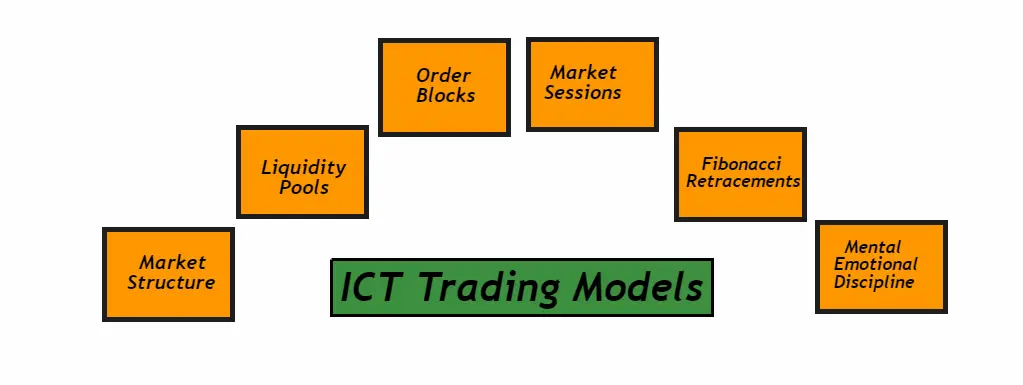The world of forex trading is both exciting and daunting, with its rapid movements and complex strategies. Among the myriad of approaches available to traders, ICT (Inner Circle Trader) trading models stand out for their depth, precision, and effectiveness. Developed by Michael J. Huddleston, these models offer a structured way to dissect market movements and identify trading opportunities. This guide delves into the essence of ICT trading models, offering insights on how to implement them in your strategy, avoid common pitfalls, and ultimately, succeed in the forex market.
Understanding ICT Trading Models
What Are ICT Trading Models?
ICT Trading Models are a comprehensive framework designed for analyzing financial markets. They combine technical analysis tools, trading concepts, and psychological insights to pinpoint high-probability trading opportunities. Named after their creator, Michael J. Huddleston, the “Inner Circle Trader” models aim to equip traders with insights akin to those of institutional players, enabling a deeper understanding of market dynamics.
Core Principles
The models rest on several foundational principles:
- Market Structure: Recognizing patterns in price movements to identify trends or potential reversals.
- Liquidity Pools: Understanding where large orders are likely to be placed and how they can influence market movements.
- Order Blocks: Identifying areas where institutional orders are placed, offering clues to potential reversals or continuations.
- Time of Day / Market Sessions: Trading during specific times can lead to more significant price movements.
- Fibonacci Retracements and Extensions: Used to forecast potential future movements.
- Mental and Emotional Discipline: A crucial, often overlooked component, focusing on the psychological aspect of trading.
Key Components of ICT Trading Models
Implementing ICT models requires an understanding of their key components, each playing a crucial role in developing a nuanced trading strategy.
Market Structure and Patterns
The backbone of ICT models is the market structure, identifying whether the market is in an uptrend, downtrend, or consolidation phase. This understanding guides traders in making informed decisions about their entry and exit points.
Liquidity and Order Blocks
Liquidity pools and order blocks are essential in anticipating market movements. By analyzing where these are likely to be, traders can strategize their trades around these pivotal points, improving their chances of success.
Strategic Timing
The models emphasize the importance of trading during specific market sessions or times of day when liquidity and volatility are higher. This approach can lead to capturing more significant price movements.
Fibonacci Tools
Incorporating Fibonacci retracements and extensions provides traders with a mathematical basis for predicting potential support and resistance levels, further refining their trading strategy.
Benefits of Using ICT Trading Models
Adopting ICT trading models brings several advantages, enhancing both the strategic approach to trading and the psychological mindset needed for success.
Enhanced Market Analysis
The comprehensive nature of ICT models allows for a more in-depth market analysis, leading to a better understanding of market dynamics and more informed trading decisions.
Precision in Trading
ICT models facilitate precise entry and exit points, optimizing risk-reward ratios, and improving the potential for profit through strategic positioning and efficient market timing.
Risk Management
One of the cornerstones of ICT models is the emphasis on risk management, teaching traders to manage their exposure carefully and make decisions based on analysis rather than emotion.
Psychological Discipline
ICT models also focus on the importance of mental and emotional discipline in trading, promoting a calm, calculated approach to the market, essential for long-term success.
How to Implement ICT Trading Models in Your Strategy
Education and Practice
The first step in adopting ICT models is thorough education and practice. Understanding the core concepts and applying them in real-market conditions is crucial. Utilize demo accounts to practice without financial risk.
Market Analysis and Planning
Regular market analysis is essential. Identify the market structure, and look for ICT-specific setups like order blocks near liquidity pools. Develop a detailed trading plan for each trade, including entry, exit, and risk management strategies.
Continuous Learning and Adjustment
Review your trades regularly to learn from both successes and mistakes. Adjust your strategy based on these insights, and remain open to continuous learning and refinement of your approach.
Transition to Live Trading
Once confident, transition to live trading with a cautious approach. Start small and gradually scale up as your consistency and confidence grow.
Common Mistakes to Avoid
Overcomplication and Inconsistency
Keep your strategy straightforward and apply ICT principles consistently. Avoid the temptation to overcomplicate your analysis or frequently change strategies.
Neglecting Market Context and Risk Management
Always consider the broader market context and adhere to strict risk management protocols. Trading without a plan or failing to manage your emotions can undermine even the most sophisticated strategies.
Unrealistic Expectations
Adjust your expectations and understand that trading success requires time, discipline, and continuous learning. Focus on the process rather than short-term outcomes.
Conclusion
ICT Trading Models offer a structured and sophisticated approach to forex trading,
emphasizing thorough market analysis, strategic planning, and psychological discipline. While the journey to mastering these models requires dedication and patience, the potential rewards in terms of improved trading performance and personal growth are substantial. By focusing on education, practice, and continuous refinement, traders can leverage ICT models to enhance their trading strategies and achieve greater success in the forex market.


